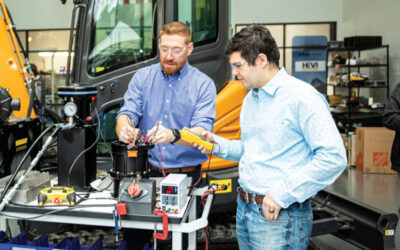Scenario
Electrification of commercial chassis means traditional mechanical PTO systems can no longer be used to power the hydraulic pumps. The obvious solution to this problem is to take the pump that would have been engine driven, attach this to an electric motor and operate as normal. The problem with this solution can be that the previous system was based around the limitations of an engine driven hydraulic pump and does not take advantage of the capabilities of the high-performance motor and control technology available now.
Solution
The Ideal solution to the electrification of hydraulic systems is to go with a pure power on demand hydraulic system and a distributed architecture. This type of system requires a complete redesign and rethinking of how hydraulic systems work. This can be a bit much when there’s already a complete shift happening on how the power train is working, ICE to electric. There are less drastic solutions that can offer similar benefits without completely blowing up a system that has probably been proven out and gradually improved over the past several decades. One of those options is an electronically controlled load sense system, this is a standard control option on all Hydrapulse Electro-Hydraulic Power units.
System Overview
Electronic Load Sense (ELS) – An Electronic Load Sense Control System is designed to be plug and play with existing load sense valve banks used in mobile or industrial hydraulic systems. This allows the end user or OEM to maintain a portion of hydraulic system that had been proven over the years, while implementing some of the benefits of the motor and controller technology.
In a standard load sense hydraulic system, the highest required load pressure at the actuator level is monitored within a valve bank through a series of shuttle and check valves. This signal pressure is then sent back to the piston pump. The pump is outfitted with a mechanical valve that allows it to compare this pressure to the main outlet pressure and vary the pump displacement based on the required flow to maintain a set pressure differential between main pressure and load pressure.
In the system diagram shown below, you’ll notice there are two internal pressure sensors within the Hydrapulse Smart Motor. One of these sensors will take in the load sense signal from the valve bank, the other will monitor the pressure on the main line feeding the valve bank. The Hydrapulse Smart motor will monitor the pressures on these lines and instead of varying displacement as a standard piston pump system, the motor speed will vary to increase or decrease the output flow and maintain the desired pressure differential. These signals are also available over CAN allowing the end user or OEM to control the motor speed as they would like.
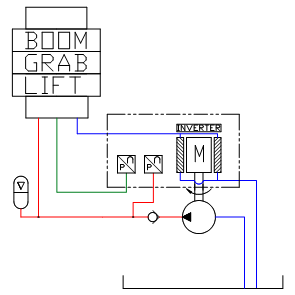
Electronic Load Sense System Example
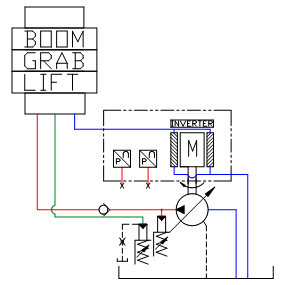
Piston pump load sense system example
Noise
There are a few benefits of a system like this, the first one is obvious during operation, variable displacement piston pumps are loud, a standard piston pump will operate in the 80-85dB on average depending on the operating speed and pressures, while a standard fixed displacement gear pump will average in the 70-75dB range with helical gear pumps running as low as 60dB. The benefits of this sound reduction are only magnified when the ELS system goes to “Zero” when no functions are being used and the piston pump is required to continue running at it’s normal operating speed.
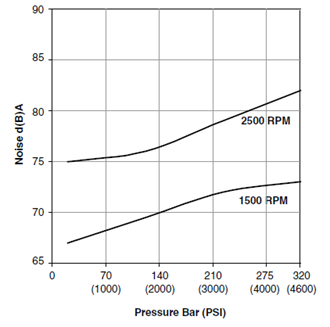
Example Noise Data for Piston Pump
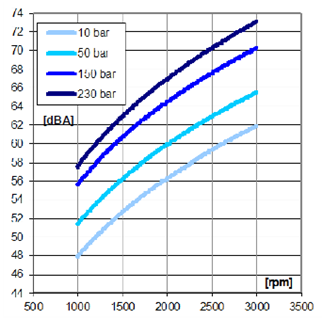
Example Noise Data for Helical Gear Pump
Efficiency
The next benefit is less obvious but will show in a very impactful way when monitoring the overall power consumption during normal operation. If we only look at the efficiency gained by immediately stopping the pump when flow is not required and eliminating the dwell time of the piston pump setup, there is an immediate elimination of a 2kw load from the system. When looking at the duty cycle of a typical mobile application like a bucket truck where there can be a significant amount of dwell time in between small movements from the operator, this 2kw load could add up to a significant battery life improvement over the course of a days work.
Variable displacement systems do offer some benefits that can be difficult to match in a fixed displacement system, like the ability to offer a very high displacement in high flow scenarios and very low displacement in high pressure situations helping to limit the motor size required. This perceived benefit can be mitigated with the higher speed capabilities of gear pumps, some of which offer speed ratings up to 4000 RPM with typical piston pumps being limited to 1800 – 2500 RPM. This results in up to a 55% reduction in required motor torque to meet the same flow/pressure requirement.



